Why are Bay Area sunsets so vibrant in the fall? Is it simply smog? – Beth, Berkeley
As someone who religiously looks for tarantulas on Mount Diablo at dusk in the fall, this is something I’ve been wondering about myself! I always know that even if I don’t come across any spiders, I will be treated to a spectacular color show as the sun slips behind the East Bay hills. But before getting to the season in question, let’s go over why sunsets are so colorful in the first place, and that explanation begins approximately 93 million miles away.
After coasting through the emptiness of space for about eight minutes, light rays from the sun meet their first real resistance when they hit Earth’s atmosphere. Sunlight is a combination of many different wavelengths, creating “white” light. But when this combination is broken up, such as with a prism, rays of different wavelengths produce different colors, ranging from red (large wavelengths) to violet (small wavelengths). The vast majority of our atmosphere is composed of tiny oxygen and nitrogen molecules, and when rays with smaller wavelengths hit these molecules, they scatter and are bounced around the atmosphere — thus causing the sky to look blue. Interestingly, the color of the sky is actually closer to violet in hue, but human eyes are more sensitive to blue. Other animals likely perceive the sky’s color in a totally different way.
This is what happens during midday, when the sunlight is hitting our atmosphere at a direct angle. At both dawn and dusk, the sun’s rays travel a significantly greater distance through the atmosphere before reaching us humans. This means that nearly all of the light in the blue and violet spectrum has been scattered before we get a chance to see it, leaving us the familiar red, pink, and orange hues we so love.
It is often said that pollution, smog, or haze produce more vivid sunsets but, alas, that is not actually true. The particles which make up smog and smoke are significantly larger than the puny gas molecules of our atmosphere so, rather than scatter some colors, they block nearly all of them, making our sunsets less vivid. In the Bay Area we experienced this last fall with smoke from the Napa and Sonoma fires. Colors were much more subdued, although the sun would become incredibly red just before it set. As red has the largest wavelengths of visible light, I suspect that these were the only rays able to penetrate the large smoke particles.

So what does cause the uptick in vivid sunsets during the fall? Changes occurring in both wind patterns and the angle of the sun are the prime culprits. As winds from the northern part of the continent move south, haze particles from the sluggish summer months are blown out of the Bay Area and replaced with cleaner, drier air, thus increasing color vibrancy. And remember, as we move away from summer the sun is hitting Earth at a lower angle, meaning even more atmospheric scattering happens before the light reaches us.
And while fall sunsets might be more noticeable after the muted hues of summer, let’s not forget about winter! The best light is often seen after storms, when rain has washed out a large number of air particles and storm clouds provide a canvas for colors. Just this past January, after a few days of rain, I experienced a jaw-dropping sunset while photographing Sandhill Cranes at Staten Island Preserve. So let’s hope that some winter storms bring not only rain but great sunsets as well this winter!
Does anyone have a favorite Bay Area place to watch the sunset? Share in the comments!

Ask the Naturalist is a reader-funded bimonthly column with the California Center for Natural History that answers your questions about the natural world of the San Francisco Bay Area. Have a question for the naturalist? Fill out our question form or email us at atn at baynature.org!





